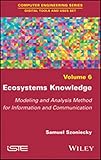Ecosystems Knowledge : Modeling and Analysis Method for Information and Communication / Samuel Szoniecky.
By: Szoniecky, Samuel [author.] .
.
Material type:  BookSeries: Computer engineering seriesDigital tools and uses set: vol. 6.Publisher: Hoboken, NJ : John Wiley and Sons, Inc. : Wiley-ISTE, 2018Description: 1 online resource.Content type: text Media type: computer Carrier type: online resourceISBN: 9781119388784; 1119388783; 9781119388777; 1119388775.Subject(s): Ecosystem services
BookSeries: Computer engineering seriesDigital tools and uses set: vol. 6.Publisher: Hoboken, NJ : John Wiley and Sons, Inc. : Wiley-ISTE, 2018Description: 1 online resource.Content type: text Media type: computer Carrier type: online resourceISBN: 9781119388784; 1119388783; 9781119388777; 1119388775.Subject(s): Ecosystem servicesOnline resource; title from PDF title page (EBSCO, viewed May 31, 2018).
Intro; Table of Contents; Introduction; 1 Use of the Ecosystem Concept on the Web; 1.1. For marketing; 1.2. For personal data; 1.3. For services and applications; 1.4. For dynamic interactivity; 1.5. For pictorial analogies; 1.6. For the information and communication sciences; 2 Ecosystem Modeling: A Generic Method of Analysis; 2.1. Hypertextual gardening fertilized by the chaos of John Cage; 2.2. An entrepreneurial experience; 2.3. The maturation of a research project; 3 Fundamental Principles for Modeling an Existence; 3.1. Key concepts for thinking about knowledge ecosystems
3.2. Spinozist principles for an ethical ontology3.3. Semantic knowledge management; 4 Graphical Specifications for Modeling Existences; 4.1. Principles of graphical modeling; 4.2. Semantic maps; 4.3. Graphical modeling rules; 5 Web Platform Specifications for Knowledge Ecosystems; 5.1. The generic management of resources; 5.2. Principles for developing a Web ecosystem platform; Conclusion; C.1. Experiments: digital humanities and e-Education; C.2. Theoretical fields to whet the appetite; C.3. Scientific practices between calculable facts and sensible intuition; Appendix
A.1. Project planning the new platformBibliography; Index; End User License Agreement
To analyze complex situations we use everyday analogies that allow us to invest in an unknown domain knowledge we have acquired in a known field. In this work the author proposes a modeling and analysis method that uses the analogy of the ecosystem to embrace the complexity of an area of knowledge. After a history of the ecosystem concept and these derivatives (nature, ecology, environment) from antiquity to the present, the analysis method based on the modeling of socio-semantic ontologies is presented, followed by practical examples of this approach in the areas of software development, digital humanities, Big Data, and more generally in the area of complex analysis. '


There are no comments for this item.